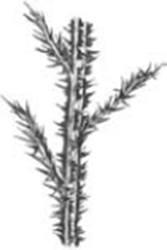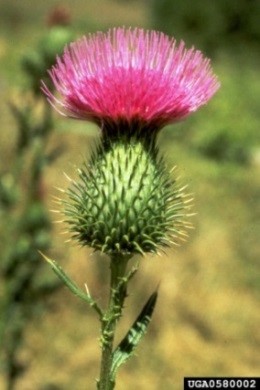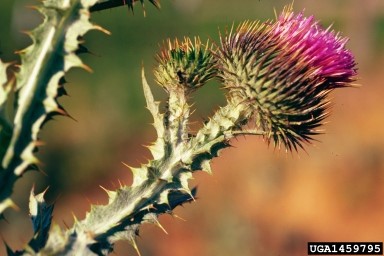Native and exotic thistles- August 2014
Native and exotic thistles: Who’s Jeckyl, who’s Hyde?
Download this weed post on thistles as a PDF
Five species of exotic thistles are found in Montana, and some of them are quite problematic
across a variety of habitats. In addition to exotic thistles, there are ten thistles
native to Montana that can be difficult to distinguish from the troublesome exotics!
Why is it important to distinguish exotic from native thistles? Exotic
thistles can spread quickly, especially with disturbance, they have poor forage value,
and their sharp spines can injure livestock and limit recreational activities. In
contrast to exotics, native thistles are rarely or ever reported as invasive and play
an important role in the ecosystem. For example, birds feed on thistle seed, and
some birds time their nesting around thistle flowering because they use the downy
seeds to line their nests. Bees, wasps, flies and beetles feed on thistle pollen and
become food sources for other wildlife, and some native thistles are forage for deer
and elk. In addition, native thistles fill a niche in the plant community.
Consider the innocuous native wavyleaf thistle, Cirsium undulatum, which may occur
on roadsides. It’s often sprayed because it’s assumed to be a troublesome exotic;
once removed the resulting open niche may be filled by an exotic plant that may be
noxious (or just obnoxious!) and hard to control. Answer the following
questions to distinguish exotic thistles from native thistles. When in doubt, contact
the MSU Schutter Diagnostic Lab (406-994-5150; http://diagnostics.montana.edu) for help with identification, and try sending a photo to [email protected] (a less painful option than submitting a plant).
1) Does the thistle have rhizomes?
Yes? It’s the exotic Canada thistle (Cirsium arvense), the only rhizomatous thistle in Montana. Heads are small and clustered, and there are no spiny wings on stem.
No? Continue to question 2.
2) Does the thistle have spiny wings the entire length of the stem?

Exotic thistles, except Canada, have spiny wings
on the stem.
Yes? It’s one of four exotic thistles. Review the key diagnostic features and photos
below.
- Bull Thistle (Cirsium vulgare). Narrow, needle-like bracts, green foliage.
- Musk thistle (Carduus nutans). Broad triangular bracts point outward or down, heads are often nodding. There may be an expanse immediately below the flower head without spiny wings, but you will see them lower on the stem.
- Plumeless thistle (Carduus acanthoides). Flower heads in clusters so each flower stalk is ≤0.75 inches, each head measures ≤1 inch in diameter
- Scotch Thistle (Onopordum acanthium). Foliage silver gray in appearance, plants may grow up to 12 feet tall, spiny wings especially prominent.
No? You likely have a native thistle. To read descriptions of native thistles see
“Manual of Montana Vascular Plants” (2012) by Peter Lesica. To confirm identity, submit
it to the MSU Schutter Diagnostic Lab.
Bull thistle (LT Kok)

Musk thistle (B Haynold)

Spiny plumeless (G Piper)

Scotch thistle (S Dewey)

